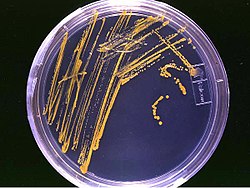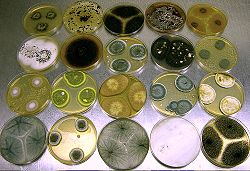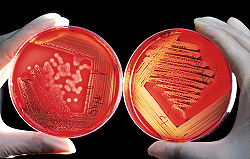Agar plate

An agar plate is a Petri dish that contains agar and some nutrients (food for the microorganisms). It is used to grow microorganisms. For example, a blood sample of a patient may be put on agar plate, to let the bacteria that made the patient sick grow. These bacteria can then be identified using a microscope to let the doctor choose the appropriate treatment of the patient.
When microorganisms grow on the agar plate, they form colonies. Each colony has similar genetic characteristics.
There are many types of agar plates that are used, but the two main types are defined and undefined. An undefined plate's nutrients aren't exactly known, but everything in a defined plate is accounted for.
Agar Plate Media
An agar plate being viewed in an electronic colony counter
An agar culture of E. coli colonies
Example of a workup algorithm of possible bacterial infection in cases with no specifically requested targets (non-bacteria, mycobacteria etc.), with most common situations and agents seen in a New England community hospital setting. Different agar plates are used for different specimen sources as seen in upper left quadrant.
Red blood cells on an agar plate are used to diagnose infection. On the left is a positive Staphylococcus infection, on the right a positive Streptococcus culture.
Hemolyses of Streptococcus spp. (left) α-hemolysis (S. mitis); (middle) β-hemolysis (S. pyogenes); (right) γ-hemolysis (= nonhemolytic, S. salivarius)
Four types of agar plate demonstrating differential growth depending on bacterial metabolism
Aspergillus niger growing on potato dextrose agar
Related pages
+{{{1}}}−{{{2}}}









